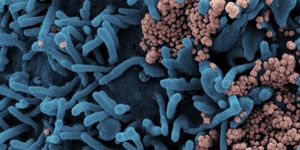Make Edits to Whole Genes With This New Technique
Though the CRISPR-Cas9 gene editing tool has been tweaked and modified in many ways, it typically edits only small portions of the genome. A guide RNA (gRNA) that carries the DNA-cutting Cas9 enzyme to the right location in the genome is made up of about 20 bases, and targets small regions. Prime editing was created a few years ago to make larger changes, up to a few dozen base pairs in length, and without cutting both strands of the genome. But scientists have now altered prime editing to edit even bigger parts of the genome.
Reporting in Nature Biotechnology, twin prime editing (twinPE), can make two edits in adjacent sections of DNA, which enables larger pieces of DNA to move in, with few unwanted changes. The researchers are hopeful that this tool could eventually be used to insert entire genes into cells so that mutated or missing genes can be totally replaced in the case of disease, one of the ultimate goals of genetic engineering.
Scientists demonstrated the feasibility of the tool by editing human cells that were modeling a genetic disorder called Hunter syndrome. In that disease, a massive chunk of DNA that is 40,000 base pairs long is inverted. In this study, twinPE was used to cause an inversion of roughly the same length at the same location in the genome where the Hunter syndrome mutation occurs; the researchers successfully corrected the genetic error that causes Hunter syndrome. In other experiments, twinPE was used to add sections of DNA thousands of base pairs long into precise locations in the genome, including those that are clinically relevant and could be used therapeutically.
“Inserting a healthy gene in a patient at a site of our choosing without generating double-strand breaks and mixtures of byproducts has been one of the longstanding challenges in gene editing,” said senior study author David Liu, a professor at Harvard University and Howard Hughes Medical Institute investigator among other appointments.
In twinPE, two prime editing gRNAs direct an editor protein to the right genomic location to make a nick in one strand of the genome for each targeted site, but without cutting through the DNA entirely. New complementary DNA is synthesized to fill in a desired sequenced between the two nicks, because the prime editor can form a complex with reverse transcriptase, an enzyme that writes RNA into DNA. Insertions, deletions, and substitutions of up to 800 base pairs were made using this approach.
“It’s been a longstanding aspiration of many labs including ours to be able to advance gene therapy in the way that scientists have advanced gene editing over the past several years,” Liu said.
Sources: Broad Institute, Nature Biotechnology










